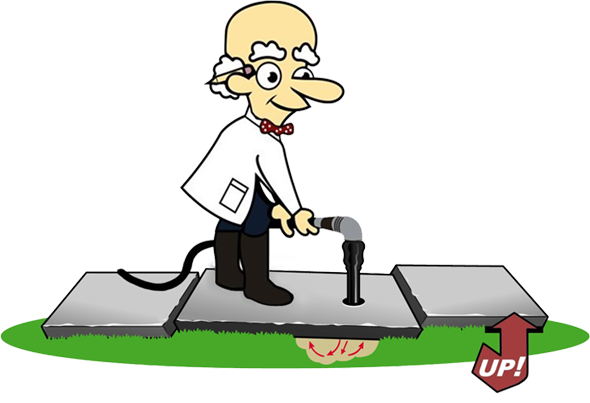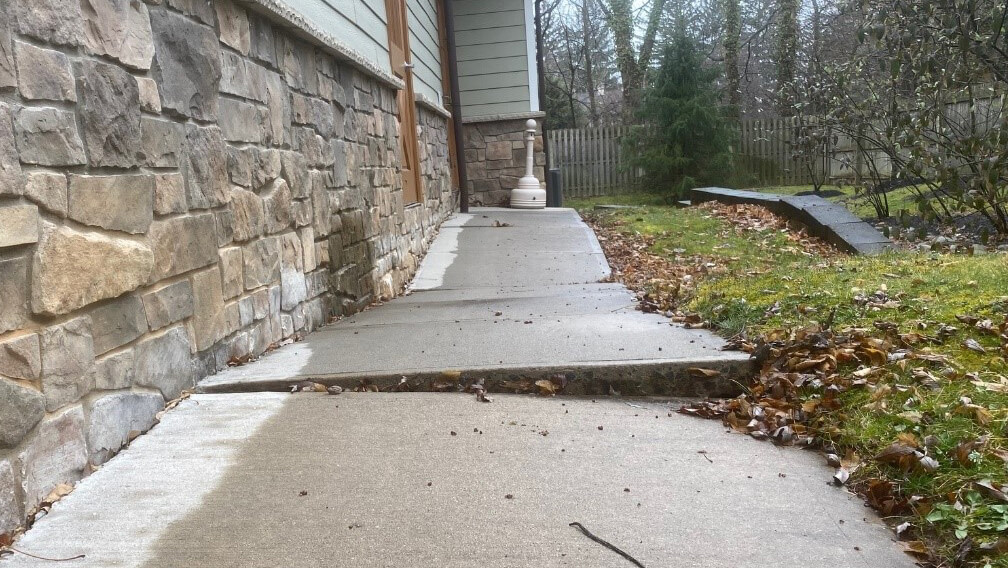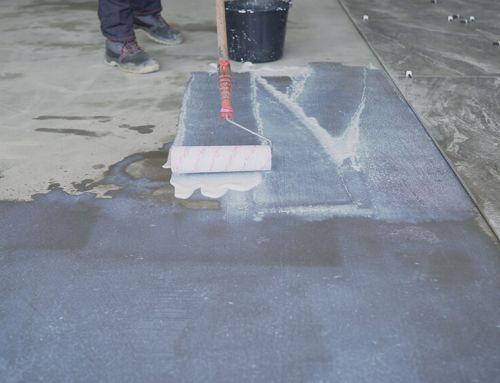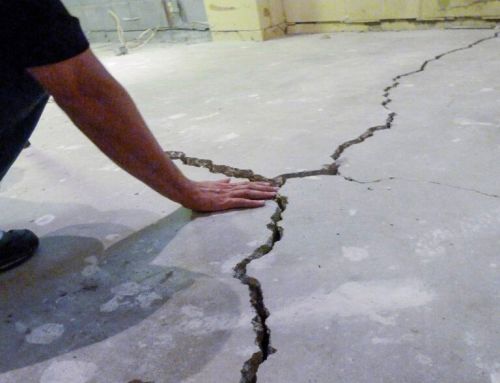IN THIS ARTICLE
Introduction
What is concrete settlement? Concrete settlement occurs when a concrete slab sinks and cracks due to soil movement or loose soils reconsolidating.
Concrete settlement has different causes, and a resolution can be challenging, manifesting in cracks, uneven surfaces, and structural compromise. Most settlements occur from poorly compacted fill soils in the initial ten years after construction.
This informative article will explore what causes concrete settlement and provide practical solutions to rectify this common issue.
Causes of Concrete Settlement
- Soil Shrinkage and Swelling: The behavior of the soil beneath a structure plays a pivotal role in concrete settlement. Expansive clay soils, prevalent in some regions of the country, can undergo significant drying and shrinking during dry periods. The soil dries, compresses, and settles, leading to slab settlement.
- Poor Soil Compaction: Inadequate soil compaction during construction can contribute to the concrete settlement. Poorly compacted soil fails to provide the necessary support, resulting in settlement over time. Loose backfill around patios, pool decks, and garage floors often causes concrete settlement near homes. It can also happen on concrete floors inside houses, sidewalks, and porch tops.
- Erosion: Soil erosion, caused by factors like water runoff from poor grading, downspouts discharging next to patios, walkways, and driveways, poor drainage, or natural geological processes, can diminish the concrete slab support, leading to settlement of concrete.
- Organic Material Decomposition: The presence of organic materials, such as tree roots, construction debris, or buried vegetation, beneath the concrete can lead to decomposition. As these materials break down, voids form, causing the concrete to settle.
- Water Infiltration: Excessive water infiltration caused by flooding or a high-water table into the soil beneath concrete weakens its density and strength, resulting in settlement as the concrete settles into the compromised soil.
- Burrowing Pests and Animals: Pests that burrow, like Chipmunks, Opossums, Woodchucks, Moles, Rats, Snakes, and Mice, are notorious for excavating and shifting soils beneath concrete. When rodents and animals dig or remove soil, empty spaces or voids form under a concrete slab, causing it to sink.
- Plumbing Leak: As soil and concrete settlement take place and plumbing lines under concrete age weaken, it is possible to develop a broken water line or sewage discharge line. As these lines leak over time, soil erosion and washout occur, creating voids or an empty space.
Recognizing Concrete Settlement: Identifying signs of concrete settlement is crucial for timely intervention. Common indicators include:
- Cracks: Visible cracks on the surface of concrete or along walls, regardless of their orientation – vertical, horizontal, or diagonal, indicate settling and should be dealt with immediately.
- Uneven Surfaces: Irregular seams or a slanted concrete floor indicate that the concrete slab has subsided and is leaning. Another sign is a cement line on a wall above the level of the concrete floor slab. This is common in garages with floor settlement.
- Doors and Windows Misalignment: Concrete floor settlement in homes or buildings can lead to misaligned doors and windows, making them challenging to operate. Signs of settlement may also be visible through cracked sheetrock walls or a space between the concrete floor and a wall’s base trim molding.
- Pooling Water: Water collecting around the base or on a concrete slab area could indicate that the ground is sinking. This sinking can cause water not to pitch or drain properly away from the house.
Settling Concrete Repair Techniques:
Addressing concrete settlement involves a combination of preventive measures during construction and targeted remediation techniques for existing structures.
- Proper Site Preparation: Thorough site preparation is essential to prevent settlement. This includes proper soil compaction techniques, removal of organic materials, and establishing effective drainage systems.
- Mudjacking or Slabjacking: Concrete leveling is more cost-effective than replacing concrete to fix sinking concrete. It involves injecting cement or foam under the slab to lift it back up. Mudjacking is the original method, used since the 1930s, where soil is replaced under the slab to raise it.
- Drainage Improvement: Installing proper drainage systems, such as French drains or surface grading, redirects water away from the foundation, reducing the risk of soil erosion and settlement.
- Concrete Void Filling: If a space under the slab is noticeable, filling voids under concrete slabs with mud jacking or foam will support and help prevent sinking concrete.
Concrete settlement can be an issue with various underlying causes, and recognizing the signs early on is crucial for effective remediation. Whether through preventive measures during construction or targeted interventions for existing structures, addressing concrete settlement requires a comprehensive approach.
Understanding the reasons behind these issues is essential to prevent concrete from cracking, breaking, and settling. These reasons include soil behavior, drainage, and support. By understanding these reasons, we can take proactive measures and use suitable repair methods.
By implementing proactive measures and appropriate concrete repair methods, we can make concrete durable and stable by addressing the soil under the slab. In conclusion, a well-informed approach is vital to finding solutions for your concrete settlement.
The Concrete Chiropractor® team has evaluated sunken concrete problems in NJ and Eastern PA since 2000. Contact us for a professional evaluation or find more related articles on our Learning Center, like the following:
Filling Voids Under Concrete Slabs: Causes And Repair Solutions
What is Mud Jacking And How Is It Done?
Is Concrete Lifting Foam A Good Idea?
- Garage Floor Raising and Coating: The Ultimate Guide - June 4, 2024
- Mudjacking Cost: 5 Factors That Affect It - April 10, 2024
- What is The Average Cost of Concrete Leveling in Belle Mead, NJ? - April 4, 2024








